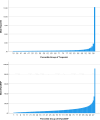Cardiac biomarkers for detection of coronary artery disease in the community
- PMID: 39681613
- PMCID: PMC11649811
- DOI: 10.1038/s41598-024-82777-x
Cardiac biomarkers for detection of coronary artery disease in the community
Abstract
To investigate whether coronary artery disease (CAD) burden is associated with plasma levels of the myocardial biomarkers Troponin I (TropI) and NT-proBNP in a large population-based sample using a cross-sectional design. Coronary computerized tomography (CT) angiography was performed in 25,859 subjects without a history of atherosclerotic disease from SCAPIS study (age 50-65, 52% women). TropI and NT-proBNP were measured in plasma. Segment involvement score (SIS) was the primary exposure and TropI the primary outcome. Both SIS and coronary artery calcium score, were associated with TropI levels following adjustment for age, sex and multiple confounders (p < 0.001), with similar relationships in men and women. Proximal segments from all three coronary arteries were related to TropI levels independently of one another. Adding TropI to traditional risk factors marginally increased discrimination of atherosclerosis as compared to risk factors alone (C-statistics + 0.0005, p = 0.014). SIS was related also to NT-proBNP levels, mainly in men, but with lower estimates than TropI. The burden of CAD was related to TropI levels in both men and women. All three major coronary arteries contributed to this relationship. Adding TropI to traditional risk factors resulted in only marginally improved discrimination of coronary atherosclerosis.
Keywords: Coronary atherosclerosis; Epidemiology; NT-proBNP; Population; Troponin.
© 2024. The Author(s).
Conflict of interest statement
Declarations. Competing interests: J.A. reports lectures fees from Boehringer Ingelheim, AstraZeneca, MSD, Bayer, and Novartis, support for abstract presentation from Novartis, and advisory board reimbursement from AstraZeneca and Novartis. T.A. reports speakers’ honoraria from AstraZeneca, Vifor Pharma, Boehringer Ingelheim and Pharmacosmos, and participation on advisory boards for Vifor Pharma and Pharmacosmos. E.H. reports support from Uppsala University, , small personal fees from AMGEN, NovoNordisk, Bayer, AstraZeneca, fees for charing the Swedish secondary prevention registry and work as national coordinator for DalCore. M.L. reports payments from Bonnier Health Care, payments for pectures and educational events from AstraZeneca, NovoNordisk, Amarin, and Amgen as well as being principal investigator for the AstraZeneca DAPA-MI study in Malmö. J.S. reports, speaker honoraria from Bayer, AstraZeneca, Medtronics, Boehringer Ingelheim, Novo Nordisk, being president of the Swedish Society for Hypertension, Stroke and Vascular Medicine, the Swedish representative and advisory board member for VAS (Vascular Independent Research and Education European Organisation), and being a minor shareholder in Beat Vascular Health. S.S reports speakers’ honoraria from Actelion Ltd and support for meetings from Actelion Ltd. The rest of the authors declare no conflicts of interest.
Figures



References
-
- Eggers, K. M., Venge, P., Lindahl, B. & Lind, L. Cardiac troponin I levels measured with a high-sensitive assay increase over time and are strong predictors of mortality in an elderly population. J. Am. Coll. Cardiol.61(18), 1906–1913 (2013). - PubMed
-
- Blankenberg, S. et al. Contribution of 30 biomarkers to 10-year cardiovascular risk estimation in 2 population cohorts: the MONICA, risk, genetics, archiving, and monograph (MORGAM) biomarker project. Circulation121(22), 2388–2397 (2010). - PubMed
MeSH terms
Substances
LinkOut - more resources
Full Text Sources
Medical
Research Materials
Miscellaneous

